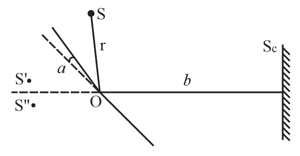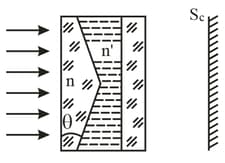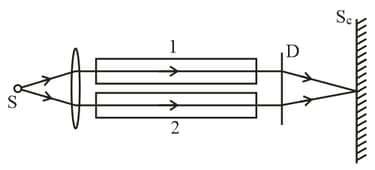I E Irodov Solutions for Chapter: OPTICS, Exercise 2: INTEREFENCE OF LIGHT
I E Irodov Physics Solutions for Exercise - I E Irodov Solutions for Chapter: OPTICS, Exercise 2: INTEREFENCE OF LIGHT
Attempt the practice questions on Chapter 5: OPTICS, Exercise 2: INTEREFENCE OF LIGHT with hints and solutions to strengthen your understanding. Problems in General Physics solutions are prepared by Experienced Embibe Experts.
Questions from I E Irodov Solutions for Chapter: OPTICS, Exercise 2: INTEREFENCE OF LIGHT with Hints & Solutions
Two coherent plane light waves propagating with a divergence angle fall almost normally on a screen. The amplitudes of the waves are equal. Demonstrate that the distance between the neighbouring maxima on the screen is equal to , where is the wavelength.
Figure illustrates the interference experiment with Fresnel mirrors. The angle between the mirrors is the distances from the mirrors' intersection line to the narrow slit and the screen are equal to and , respectively. The wavelength of light is . Find:
(a) the width of a fringe on the screen and the number of possible maxima;
(b) the shift of the interference pattern on the screen, when the slit is displaced by along the arc of radius , with centre at the point ;
(c) at what maximum width of the slit, the interference fringes on the screen are still observed sufficiently sharp.

A plane light wave falls on Fresnel mirrors with an angle between them. Determine the wavelength of light, if the width of the fringe on the screen .
A lens of diameter and focal length was cut along the diameter into two identical halves. In the process, the layer of the lens, in thickness, was lost. Then the halves were put together to form a composite lens. In this focal plane, a narrow slit was placed, emitting monochromatic light with wavelength . Behind the lens a screen was located at a distance from it. Find:
(a) the width of a fringe on the screen and the number of possible maxima;
(b) the maximum width of the slit at which the fringes on the screen will be still observed sufficiently sharp.
The distances from a Fresnel biprism to a narrow slit and a screen are equal to and , respectively. The refracting angle of the glass biprism is equal to . Find the wavelength of light, if the width of the fringe on the screen is . For glass refractive index,
A plane light wave with wavelength falls normally on the base of a biprism, made of glass with refracting angle . Behind the biprism there is a plane-parallel plate, with the space between them filled up with benzene . Find the width of a fringe on the screen placed behind this system.

A plane monochromatic light wave falls normally on a diaphragm with two narrow slits, separated by a distance . A fringe pattern is formed on a screen placed at a distance behind the diaphragm. By what distance and in which direction will these fringes be displaced, when one of the slits is covered by a glass plate of thickness ? For glass
Figure illustrates an interferometer used in measurement of refractive indices of transparent substances. Here is a narrow slit illuminated by a monochromatic light with wavelength , and are identical tubes with air of length each, is a diaphragm with two slits. After the air in tube was replaced with ammonia gas, the interference pattern on the screen was displaced upward by fringes. The refractive index of air is equal to . Determine the refractive index of ammonia gas.

